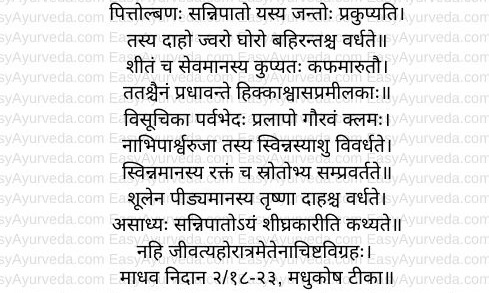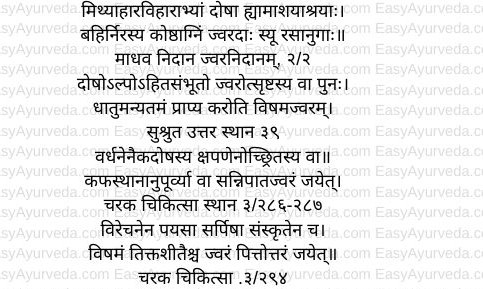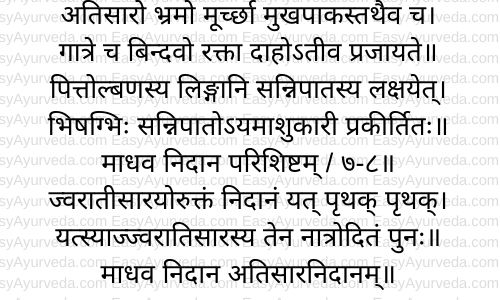Typhoid In Ayurveda: Symptoms, Causes, Prognosis, Treatment
By Dr Raghuram Y.S. MD (Ay) & Dr Manasa, B.A.M.S
Typhoid is an acute illness associated with fever caused by Salmonella enteric serotype Typhi bacteria and also by Salmonella paratyphi.
Typhoid can be classified broadly under ‘jwara’. Though jwara is a broader concept it is commonly compared with fever. In fact jwara is a common term used to describe fevers of different kinds and is even used by common man in some parts of India.
Read – Typhoid Fever – Causes, Symptoms, Complications, Prevention, Treatment

Table of Contents
Ayurveda understanding of Typhoid
Ayurveda has given an elaborate explanation of jwara in the treatises. The classification of fever is also elaborate. As such any particular type of fever cannot be strictly compared with typhoid in complete terms. We need to go through the elaborate classification of fevers explained in Ayurveda and shortlist a couple of conditions which stand as closest comparison to the modern day typhoid.
Conditions which can be closely correlated with typhoid –
1. Pittolbana Vishama Sannipata / Ashukari Sannipata
Sannipata Jwara is a type of fever which is caused by aggravation of all three doshas. If they are vitiated in equal proportions it is called as sama sannipata. If the doshas are vitiated in unequal proportions or have undergone relative imbalance it will be called as vishama sannipata. Typhoid fever is compared to this condition. Therefore typhoid is a type of fever caused by unequal imbalance of the three doshas. This type of fever is also called as ashukari sannipata. Ashukari means that which quickly causes complications or is life threatening. Typhoid in its full form, with all complications manifested is life threatening.
Read – Causes, Symptoms, Treatment Of Recurring Fevers Punaravartaka Jwara
This type of fever manifests in 2 forms –
Antardaha – increased heat / burning sensation present inside the body but is not experienced outside, on the surface of the body
Bahirdaha – increased heat / burning sensation present outside the body but is not experienced inside the body
In this condition the patient is forced to consume cold foods and comforts to pacify the excessive heat and burning sensation caused due to immensely vitiated pitta. When cold things are consumed the below mentioned symptoms are manifested.
Symptoms of Pittolbana Vishama Sannipata (Ref – Bhaluki Tantra – Shighrakari Sannipata)
Hiccough
Breathlessness
Excessive sleepiness
Dysentery / diarrhea
Pain in the joints
Delirium
Heaviness
Fatigue
Pain in the navel and flanks
Excessive sweating
Bleeding from the channels of the body
Colic
Excessive thirst
Excessive burning sensation
Other symptoms (Ashukari Sannipata – Madhava Nidana – Parishishta)
Diarrhea
Giddiness
Fainting
Mouth ulcers
Red spots are manifest on the body
Severe burning sensation
Read – Jwara Pravritti – The Initial Manifestation
Prognosis – This condition is said to be incurable. The patient is said to lose his life within 24 hours and hence this condition is called as shighrakari or ashukari sannipata. Actually all cases of typhoid are not life threatening and all conditions do not end in death. Only typhoid with severe complications might lead to death if not managed properly at the right time.
Ayurveda might have highlighted the ultimate effect of ill-managed fever with severe complications to explain the grave nature of the disease and also to alert the physician to manage the condition promptly and as quickly as possible. The time duration mentioned too might indicate the final few hours of complicated stage of the fever.
Antrika Jwara – This fever is also called as antrika jwara. Antrika means intestinal. Jwara means fever. Typhoid too afflicts the intestines. Bleeding inside the intestines and intestinal perforation are the common life-threatening complications of typhoid. When these occur, typhoid becomes incurable. The fever is intense before bleeding or perforation takes place. But once bleeding or perforation occurs, the temperature of the body falls down, the pulse becomes rapid, severe colic occurs, the patient feels severe thirst and cold sweating occurs. This indicates a bad prognosis of typhoid.
The symptoms found in this fever are also found in typhoid fever. On the other hand, the modern texts have explained plenty of complications, system-wise.
Read – Charaka – Jwara Chikitsa 3rd Chapter
Typhoid prognosis
Prognosis of typhoid depends on how quickly it is diagnosed and prompt initiation of treatment. Untreated typhoid carries a mortality rate of 15-30%. In properly treated cases mortality is less than 1%.
Many patients experience long term or permanent complications. These include neuropsychiatric symptoms and high rates of gastrointestinal cancers.
Read more about – Typhoid prognosis – Modern view.
In general conditions, this sannipata fever is curable. But when complications occur or when one consumes incompatible and bad foods, this condition becomes incurable and this condition is explained in Ayurveda treatises.
2. Santata (Vishama) Jwara
Typhoid fever is also compared to Santata Jwara. Vishama Jwara means irregular fevers. This is of 5 types. Among them Santata Jwara is one. Santata means continuous fever. The fever in which the fever is present continuously is called as santata jwara. We can see a similar pattern in typhoid fever too. In Santata fever the fever is continuously present for many days. The fever doesn’t reduce at any time. The temperature too is constantly higher. This type of fever is also found in pneumonia and cerebro-spinal fever apart from typhoid.
The number of days the fever persists differs depending on the predominant involvement of doshas. The fever comes down in
7 days in vata predominant santata fever
10 days in case of pitta predominant santata fever
12 days in kapha predominant santata fever
In some exclusive conditions this fever may persist for many days.
Read – Charaka Jwara Nidana: 1st Chapter
3. Jwaratisara
The word Jwaratisara is made up of two terms – Jwara and Atisara which means diarrhea. This condition is explained in the chapter explaining diarrhea in Madhava Nidana treatise, at the end of the chapter.
The author says that the same etiological factors, premonitory symptoms, symptoms, prognosis and pathogenesis explained individually for diarrhea and fever are present in varying combinations and proportions in Jwaratisara. This explanation shows that the fever and diarrhea coexist in this condition. Nothing has been mentioned about the treatment of this condition. But we can infer that the treatments of both fever and diarrhea explained in Ayurveda treatises should be skillfully combined so as to provide effective treatment for this condition since etiological factors etc are present in a combined way.
Since typhoid is an enteric fever, fever and intestinal symptoms, mainly diarrhea are seen in the disease. Therefore Jwaratisara forms a closer comparison to typhoid.
Read – Use Of Herbal Decoctions In Fever -Kashaya In Jwara
Causes
Specific etiological factors for this condition have not been mentioned. Since it is a sannipata fever, etiological factors responsible for the causation of each individual dosha (all doshas) will be involved in mixed proportions. The pitta aggravating etiological factors have a predominant role in comparison to those aggravating vata and kapha. Vata and Kapha too will get aggravated since mixed etiological factors are responsible, but to a lesser extent in comparison to pitta.
Read – Lifestyle, Food And Factors That Cause Pitta Dosha Increase
Pathogenesis
Since separate pathogenesis for causation of this pitta predominant sannipata has not been mentioned, the general pathogenesis of fever itself has to be considered.
General pathogenesis of fever
In a person who consumes incompatible and unwholesome foods, the doshas would get vitiated and get lodged in the stomach. They get mixed with the rasa (essence of nutrition formed due to digestion of food) and put into circulation. In this way the doshas spread out all through the body. While doing so, the doshas dislodge the gut fire and throw it out of the stomach and cause fever.
When all three doshas are involved in this pathogenesis with predominance of pitta put into circulation, pittolbana sannipata / typhoid fever is manifested. In the same way since this fever is also an irregular fever, the pathogenesis of irregular fevers can also be considered for this fever.
Read – Sannipataja Dosha Dushti – When All Three Doshas Are Imbalanced
Pathogenesis of irregular fever
The doshas which are of weak strength right from the beginning or have got weakened due to remission of fever get aggravated once again due to consumption of unwholesome foods and exposure to unwholesome activities. These doshas get lodged in any one of the tissues and cause irregular fevers.
Sanskrit Verses



Ayurveda treatment of Typhoid
The following below mentioned treatment principles shall be adopted in the treatment of typhoid –
Principles of treatment of fever in general (jwara), fevers caused due to all three vitiated doshas (sannipata jwara), fever with diarrhea (jwaratisara) and irregular fevers (vishama jwara).
Read – Ayurveda Lifestyle and Diet For Fever – 45 Important Things To Know
Treatment principles of sannipata fever
One dosha should be increased and the increased dosha should be decreased (so as to bring them to balance) or it shall be treated on the lines of treating ‘seat of kapha’ – stomach in this instance (this is because the origin of fever is from stomach and as per principle the place of origin of the disease and the related doshas should be treated)
Typhoid is a tridosha fever caused by predominance of pitta. In this instance, following the treatment principle as said above, pitta reducing treatments should be done and pitta brought to balance. At the same time interventions to increase the other doshas i.e. vata and pitta and bring them to balance should be adopted.
Treatment principles of pitta predominant irregular fevers
Only treatment principles of tritiyaka and chaturthaka types of irregular fevers have been described in the texts. Typhoid is a santata type of irregular fever as already explained above.
The principles mentioned for tritiyaka and chaturthaka types of irregular fevers having predominance of pitta shall be adopted in typhoid too.
They are –
Virechana – purgation
Milk and ghee treated with pitta destroying herbs
Use of bitter tasting and cold potency herbs
The medicines and diet generally used to treat irregular fevers shall also be adopted in the treatment of typhoid.
Read – Bitter Taste – Qualities, Health Benefits, Side Effects
Ayurveda formulations to treat typhoid
Sudarshana Churna
Sudarshana Ghana Vati
Avipatti Churna
Amritottaram Kashayam
Sudarshanarishtam
Vettumaran Gulika
Sarva Jwarahara Lauha
Vishama Jwarantaka Vati
Formulations for Sannipata Jwara From Sahasra Yoga Text book
Sannipata Jwarahara Kashaya
Sannipata Jwaradihara Kashaya
Sudarsana choorna
Kacchuradi Choorna (Laghu)
Chukkum Tippalyadi Gutika
Ramachandiswara Rasa
Anandabhairava Gutika
Sannipatantaka Gutika
Chailyadi Gutika
Jwarankusa Rasa
Suchimukha Rasa
Kodarasi Gutika
Mritasanjivani Gutika
Vettumaran Gutika
Venkaradi Matra
Valiyandati Kashaya
Vijaya Bhairava Taila
Kanni Kurkiladi (Nariyal) Taila
Click to Consult Dr Raghuram Y.S. MD (Ayu)









